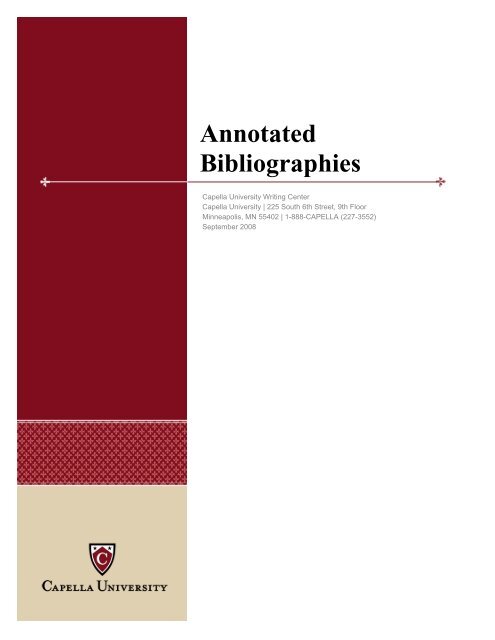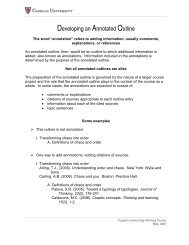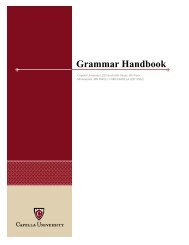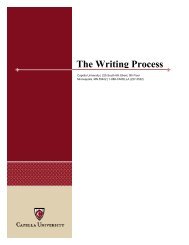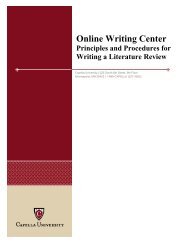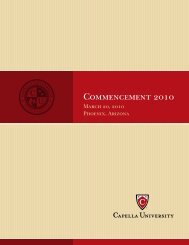Annotated Bibliographies - Capella University
Annotated Bibliographies - Capella University
Annotated Bibliographies - Capella University
Create successful ePaper yourself
Turn your PDF publications into a flip-book with our unique Google optimized e-Paper software.
<strong>Annotated</strong><br />
<strong>Bibliographies</strong><br />
<strong>Capella</strong> <strong>University</strong> Writing Center<br />
<strong>Capella</strong> <strong>University</strong> | 225 South 6th Street, 9th Floor<br />
Minneapolis, MN 55402 | 1-888-CAPELLA (227-3552)<br />
September 2008
Table of Contents<br />
Long Document Template<br />
Types of <strong>Annotated</strong> <strong>Bibliographies</strong>................................................................... 3<br />
Sample Summative Annotation .......................................................................................... 3<br />
Sample Evaluative Annotation............................................................................................ 5<br />
Uses of <strong>Annotated</strong> Bibliography ....................................................................... 6<br />
Format of <strong>Annotated</strong> Bibliography Entries (in APA style) .............................. 6<br />
Sample format for an <strong>Annotated</strong> Bibliography Entry: ......................................................... 6<br />
Organization of <strong>Annotated</strong> Bibliography Entries............................................. 8<br />
Frequently Asked Questions ............................................................................. 9<br />
2
<strong>Annotated</strong> Bibliography<br />
Long Document Template<br />
An annotated bibliography is a great tool to help scholarly writers move from the research to<br />
the drafting phase of a writing project, particularly when managing a large number of sources.<br />
A bibliography is an alphabetized list of sources relevant to a particular area of inquiry or<br />
research question; an annotated bibliography goes beyond merely giving the citation<br />
information for the sources to provide the reader with more information about the content of<br />
those sources. The content information is called the annotation.<br />
Types of annotation<br />
There are at least two different kinds of annotated bibliographies: those that are summative and<br />
those that are evaluative. Length of annotations can also vary, from approximately 150-word<br />
paragraphs to one- or two-page annotations. Occasionally some are designed with shorter<br />
annotations. If writing an annotated bibliography for a class, be sure to check with the<br />
instructor to determine which type of annotation is required for the assignment you are<br />
completing, and the preferred length required.<br />
Summative annotations provide the reader with a solid sense of the content of the article or<br />
book being annotated. They are similar to abstracts, but usually are a little more detailed and<br />
convey more aspects of the arguments being presented. Summative annotations are not as long<br />
or detailed as summaries, however, which are generally longer essay assignments in which the<br />
writer is representing all the main points of an article.<br />
Sample summative annotation:<br />
Kemp, F. (1998). Computer-mediated communication: Making nets work for writing<br />
instruction. In J.R. Galin & J. Latchaw (Eds.), The dialogic classroom (pp. 133-150).<br />
Urbana, IL: National Council of Teachers of English.<br />
Fred Kemp, associate professor of English at Texas Tech <strong>University</strong> is the<br />
author of this early investigation of the potential uses of network computing in<br />
teaching writing. 1 Opening with a historical discussion of the perceived impact<br />
of the microcomputer on writing pedagogy, he notes that while machines lack<br />
the natural language capability to become graders of student papers, they have<br />
1<br />
In the opening of this annotation, we introduce the author and his qualifications, linking to an<br />
overview of the article he has written.<br />
3
Long Document Template<br />
had great impact as network tools useful for facilitating peer review in writing<br />
instruction. 2 Through a series of examples dating back to Trent Batson’s use of<br />
networked computers to enable deaf students to communicate in writing with<br />
each other at Gaullaudet <strong>University</strong> in 1985, Kemp traces the impact of applied<br />
networking on collaborative learning theories such as Kenneth Bruffee, Thomas<br />
Kuhn, and Karen Burke LeFevre. 3 He further recalls his own work developing<br />
“The Daedalus Integrated Writing Environment” [DIWE] software for writing<br />
instruction at the <strong>University</strong> of Texas in the mid-1980s, which was a precursor to<br />
the computer-mediated communication [CMC]-based instruction that emerged in<br />
the 1990s. 4 Giving examples of student responses to networked writing and peer<br />
review assignments collected as part of the Computer-Based Writing Project at<br />
Texas Tech in the 1990s, Kemp concludes by arguing that “societal changes in<br />
information access and communication will require profound changes in the<br />
classroom and in the way most people learn” (p. 149). 5<br />
Evaluative annotations include both a description and a critical assessment of the article or<br />
book being annotated. They are designed to give the reader a sense of the quality of the source<br />
and the argumentative position of the author relative to others in the field. Some evaluative<br />
annotations are focused specifically on how the source responds or contributes to a particular<br />
research question or area of inquiry in the field. Consideration of methodology and how data<br />
were gathered are often a part of an evaluative annotation. These types of annotations may be<br />
stand-alone entries, or they may be comparative, referencing the other entries to give a total<br />
picture of how different articles on the topic are in conversation with each other.<br />
2<br />
Here we characterize the intent and purpose of the article, giving the main idea (or thesis)<br />
advanced.<br />
3<br />
Key examples and central figures cited are noted here as a means of summarizing critical<br />
content found in the article.<br />
4<br />
Kemp’s discussion of his own involvement in the development of instructional technology is<br />
related to his historical account of how network computing became instrumental in realizing<br />
the previously mentioned educational theories.<br />
5<br />
This sentence provides further information about the content of the article and ends with a<br />
quoted passage documenting Kemp’s final conclusion about the impact of technology on the<br />
writing classroom.<br />
4
Long Document Template<br />
Sample evaluative annotation (adapted from the summative example above):<br />
Kemp, F. (1998). Computer-mediated communication: Making nets work for writing<br />
instruction. In J.R. Galin & J. Latchaw (Eds.), The dialogic classroom (pp. 133-150).<br />
Urbana, IL: National Council of Teachers of English.<br />
Fred Kemp, associate professor of English at Texas Tech <strong>University</strong> is the<br />
author of this early investigation of the potential uses of network computing in<br />
teaching writing. Opening with a historical discussion of the perceived impact of<br />
the microcomputer on writing pedagogy, he notes that while machines lack the<br />
natural language capability to become graders of student papers, they have had<br />
great impact as network tools useful for facilitating peer review in writing<br />
instruction. Through a series of examples dating back to Trent Batson’s use of<br />
networked computers to enable deaf students to communicate in writing with<br />
each other at Gaullaudet <strong>University</strong> in 1985, Kemp traces the impact of applied<br />
networking on collaborative learning theories such as Kenneth Bruffee, Thomas<br />
Kuhn, and Karen Burke LeFevre. He further recalls his own work developing<br />
“The Daedalus Integrated Writing Environment” [DIWE] software for writing<br />
instruction at the <strong>University</strong> of Texas in the mid-1980s, which was a precursor to<br />
the computer-mediated communication [CMC]-based instruction that emerged in<br />
the 1990s. Giving examples of student responses to networked writing and peer<br />
review assignments collected as part of the Computer-Based Writing Project at<br />
Texas Tech in the 1990s, Kemp concludes by arguing that “societal changes in<br />
information access and communication will require profound changes in the<br />
classroom and in the way most people learn” (p. 149). Although now dated, his<br />
1998 argument was eerily prescient and the article is useful in establishing an<br />
historical account of early applications of network technology on writing<br />
5
Long Document Template<br />
pedagogy. 6 As such, this article would be helpful in a study tracing the initial<br />
impact of computers in the writing classroom as teachers first sought to put<br />
network technology to use. 7<br />
Uses of annotated bibliography<br />
<strong>Annotated</strong> bibliographies can be invaluable in the research process, especially when working<br />
with large numbers of sources over a long period of time. It is very difficult (if not impossible)<br />
to recall details about every source on a given topic. Well-written annotations can help<br />
crystallize key information presented in each article or book, preserving it in a format that can<br />
be easily accessed and revisited at any stage of the writing process.<br />
An annotated bibliography can be created in response to a specific research question, or it<br />
might represent exploratory research on a broader topic at an earlier stage of the research<br />
process. Writing about each source individually helps clarify and situate the perspectives of<br />
different scholars and their approaches to a given topic. In this way, the annotated bibliography<br />
can serve as the basis of a review of literature; it functions as the “nuts and bolts” of the<br />
research, laying out different themes and positions that have emerged about the topic in the<br />
literature of the field.<br />
Format of annotated bibliography entries (in APA style)<br />
The basic format of each entry in an annotated bibliography is simple: begin with a complete<br />
reference list citation in correct APA format, and follow that citation with the annotation. Use<br />
hanging indent for the whole paragraph, just as you would for the citation alone, and doublespace<br />
the entire entry.<br />
The following example illustrates the format for an annotated bibliography entry:<br />
Shor, I. (1992). Empowering education: Critical teaching for social change. Chicago:<br />
<strong>University</strong> of Chicago Press.<br />
This book by Ira Shor, a professor of English at the City <strong>University</strong> of New<br />
6 In this sentence, we move from summary of the content of the article to an evaluative<br />
statement assessing its purpose and value, advancing a critique based on its age while noting<br />
some strengths that make it useful for contemporary research.<br />
7 The addition here of a final evaluative statement suggests why the article will be of interest to<br />
a researcher pursuing a particular research project.<br />
6
Long Document Template<br />
York, offers new pedagogical methods of “critical teaching for social change.” 8<br />
The author, who teaches composition and basic writing courses, integrates his<br />
own classroom experiences with a discussion of Freirean and other pedagogical<br />
theories. 9 Beginning with the politics of socialization in the education system,<br />
Shor makes a case for empowering (as opposed to traditional) education, defined<br />
as “a critical-democratic pedagogy for self and social change” (p. 15). 10 Student<br />
participation, he argues, is a key element of this model, and it is up to the teacher<br />
to foster positive feelings about the class and invite participation from the<br />
students. This can be achieved by a technique called “problem-posing,” in which<br />
the teacher generates a dialogue in class rather than delivering information in a<br />
lecture format. 11 Problem-posing is especially helpful as a strategy in a<br />
multicultural classroom, since it underscores the impact of situated learning, in<br />
which students establish their own vantage point and knowledge in relation to<br />
the course material. 12 By discussing student resistance in terms of actual<br />
classroom examples, Shor applies pedagogical theory to his own experiences<br />
and makes the application of Freire’s ideas clear in a contemporary American<br />
educational context. 13<br />
8 Here we establish the identity of the author and his qualifications, as well as offering a key<br />
phrase quoted from the text to establish the main idea conveyed in the text.<br />
9 This sentence serves as a description of the methods and theories used in the text.<br />
10 By incorporating a direct quote, we establish the main point Shor is making and link that to a<br />
discussion of the content of the book.<br />
11 Here we introduce a key term central to his argument, defining it are relating it to the overall<br />
point Shor is making in the text.<br />
12 This sentence offers insight into a potential application of Shor’s pedagogy, in this case its<br />
use specifically in the multicultural classroom.<br />
13 In this final sentence, Shor’s methodology is explained in a description of the purpose and<br />
particular value of the text. This is a summative annotation; an evaluative one would be<br />
followed by more specific statements addressing the strengths and weaknesses of the book, as<br />
well as its specific relevance to a particular research topic or project.<br />
7
Organization of annotated bibliography entries<br />
Long Document Template<br />
Entries in annotated bibliographies are typically placed in alphabetical order; however, it is<br />
also possible to organize entries according to a theme or particular aspect of the topic. This is<br />
most frequently done in cases of longer annotated bibliographies involving many sources, and<br />
can be a really helpful way to further organize or highlight the sources pertaining to different<br />
aspects of the research topic. Another way to think about this is as a longer annotated<br />
bibliography divided into a series of shorter ones, each with its own subheading focused on a<br />
theme or specific approach to the larger topic. Organizing an annotated bibliography in this<br />
way can make it very easy to develop a well-structured review of literature from the research<br />
you have done on a scholarly topic.<br />
8
Frequently Asked Questions<br />
Long Document Template<br />
Why did my instructor assign an annotated bibliography as part of my research project?<br />
The annotated bibliography is helpful in allowing you as the writer to organize and assess the<br />
scholarly research you have gathered on a topic. As you write an annotation for each source,<br />
you will gain a better understanding of what each article or book contributes to the knowledge<br />
about the topic, and how each source relates to the others you have read. By the time your<br />
annotated bibliography is complete, you will have developed your critical thinking about the<br />
topic and should find it easier to begin drafting your essay or thesis.<br />
What is the difference between an abstract and an annotation? Can’t I just cut and paste<br />
the library abstract into my annotated bibliography?<br />
An abstract is usually shorter than an annotation, and is really just a brief descriptive summary<br />
of an article or essay. Library abstracts are designed to let the reader know at a glance more<br />
about the content of an article; they are useful for a cursory appraisal but don’t provide as<br />
much information about the argument being presented, nor do they evaluate the content of the<br />
work. Annotations are often more detailed and critical, allowing the reader to learn about the<br />
specific perspective of the author in relation to the topic and his or her authority to take a<br />
particular position. Cutting and pasting the library abstract would not be sufficient for an<br />
annotation, since it would not be as detailed and would not include critical evaluation of the<br />
work or specific relevance to your individual project topic.<br />
Can I use software programs to create my annotated bibliography? Why should I<br />
consider doing that?<br />
The use of reference software programs is an optional way of storing bibliographic entries in a<br />
database format. While annotated (and other) bibliographies can also be created in a word<br />
processing program, there are certain advantages to building and storing bibliographic entries<br />
in database software programs like EndNote, RefWorks, or StyleWriter. Each of these<br />
programs allows the user to link complete reference information on a source to a list of<br />
keywords, an annotation, and/or notes fields in which you can enter specific and personalized<br />
information about the work and its relevance to your own area of inquiry. Over time, these<br />
programs can allow you to build a virtual “library” of references relevant to one or more<br />
research topics, and they can be recalled and accessed later as needed through specific<br />
keyword searches. When embarking on a lengthy research project like a dissertation, the ability<br />
to save annotated sources in a thematically retrievable way is invaluable in that it enables you<br />
to locate the sources most relevant to any aspect of the project you might be working on, as<br />
well as simultaneously recalling your own notes on the content of those sources.<br />
9


